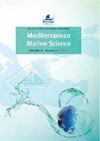Established non-indigenous species increased by 40% in 11 years in the Mediterranean Sea
IF 2.3
3区 环境科学与生态学
Q1 MARINE & FRESHWATER BIOLOGY
引用次数: 41
Abstract
Using a 2010 review of non-indigenous species (NIS) reported in the Mediterranean Sea as a baseline, this study undertakes a paramount revision of the non-indigenous species list in the region up to December 2021, re-evaluating the established, casual and failed introduction events of over 1366 taxa. In the light of new data and expert judgement, 14 species have been removed from the “established list” of the Mediterranean Sea inventory. The total number of validated NIS is close to 1000—751 established taxa and 242 casual taxa—while 23 species are considered as failed introduction. The rest are tagged as cryptogenic (58 taxa), questionable (70 taxa) or excluded (223 taxa). Mollusca have the highest diversity among established and casual NIS (230 taxa), followed by Pisces and Crustacea with 173 and 170 NIS respectively. The changes in establishment status reveal an accelerated rate of establishment (13%) between January 2020 and December 2021 (>6% yearly), compared to an establishment rate of 27% in the period 2011–2021 (<3% yearly). This increased establishment success is more pronounced in Crustacea (47%) and Pisces (43%) than in Polychaeta (27%) and phytobenthos (30%). In the period 2011–2021, 42% of the newly reported species were established (149 out of 352). On a shorter timescale, out of 79 new species reported in the period 2020–2021, 17 NIS (21.5%) have already established, a figure well above the 10% prediction of invasion theory on establishment success for Mediterranean marine NIS.地中海已确定的非本地物种在11年内增加了40%
本研究以2010年地中海报告的非本土物种(NIS)审查为基线,对截至2021年12月的该地区非本土物种清单进行了重大修订,重新评估了1366多个分类群的既定、偶然和失败引入事件。根据新的数据和专家判断,14个物种已从地中海清单的“既定清单”中删除。经过验证的NIS总数接近1000个——751个已建立分类群和242个偶然分类群——而23个物种被认为是失败的引入。其余分类群被标记为隐源分类群(58个分类群)、可疑分类群(70个)或排除分类群(223个)。软体动物在已建立的和偶然的NIS中具有最高的多样性(230个分类群),其次是双鱼类和甲壳类,分别为173个和170个NIS。机构状况的变化表明,2020年1月至2021年12月期间,机构的成立率加快(13%)(每年>6%),而2011年至2021年期间的成立率为27%(每年<3%)。这种增加的建立成功率在甲壳纲动物(47%)和鱼类(43%)中比在多毛类动物(27%)和植物底栖动物(30%)中更为明显。在2011-2021年期间,42%的新报告物种已建立(352个物种中有149个)。在较短的时间内,在2020-2021年期间报告的79个新物种中,已有17个NIS(21.5%)已经建立,这一数字远高于入侵理论对地中海海洋NIS建立成功的10%预测。
本文章由计算机程序翻译,如有差异,请以英文原文为准。
求助全文
约1分钟内获得全文
求助全文
来源期刊

Mediterranean Marine Science
MARINE & FRESHWATER BIOLOGY-
CiteScore
5.20
自引率
17.90%
发文量
34
审稿时长
>12 weeks
期刊介绍:
The journal Mediterranean Marine Science (MMS), published by the Hellenic Centre for Marine Research (HCMR), issues three volumes annually. The journal welcomes original research articles, short communications, New Mediterranean Biodiversity records, extended reviews, comments, and Theme sections in all fields of Oceanography, Marine Biology, Marine Conservation, Fisheries and Aquaculture in the Mediterranean area and the adjacent regions. All content is peer reviewed.
 求助内容:
求助内容: 应助结果提醒方式:
应助结果提醒方式:


